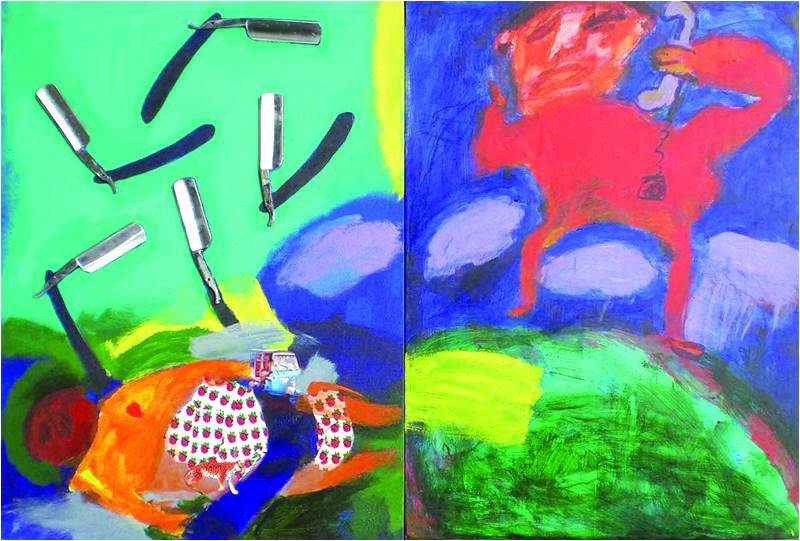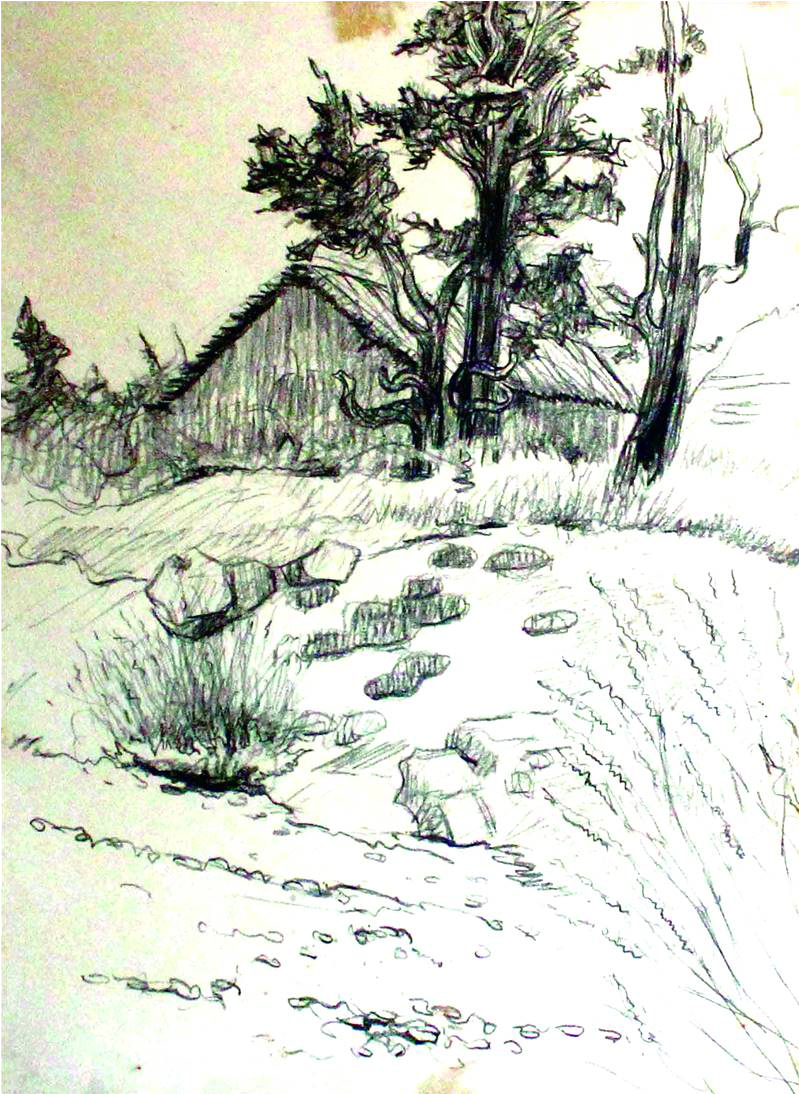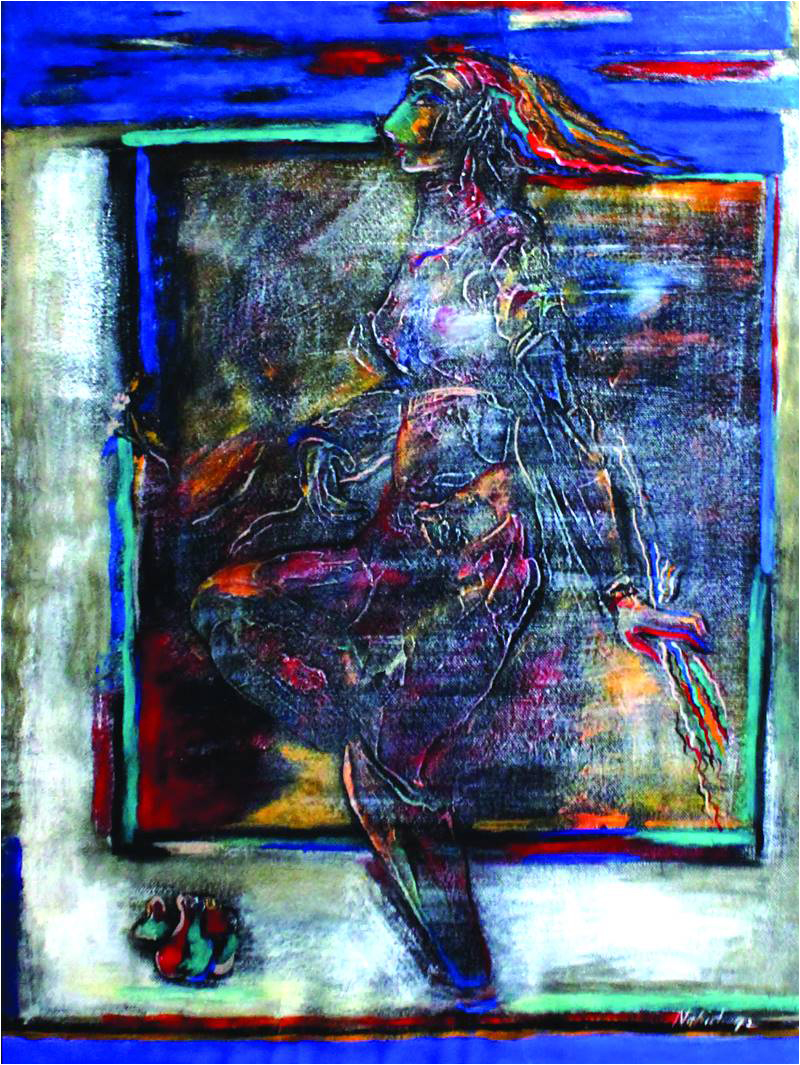
Closely related, Rehana and Shakil Saigol shared a love of art growing up in Lahore and through their married life together. We are lucky that a point has been reached where they find no space to display these works on the walls of their own and their children’s homes. And so they decided to “offload” some of their collection. Hameed Haroon curated the works for display at the Canvas Gallery.
It was great news for us, who get to view a very interesting collection of 30 works by 20 very well-known Pakistani artists done between 1952 to 2013, representing 61 years of the art history of Pakistan. It would be safe to say that anyone who visits the show will feel much the richer for the experience.
The artists on display in alphabetical order include Anna Molka Ahmed, Anwar Saeed, Imran Qureshi, Jamal Shah, Jamil Naqsh, Khadim Ali, Khalid Iqbal, Mian Ijazul Hassan, Moeen Faruqi, Mohammad Ali, Nahid Raza, Naiza Khan, Noorjehan Bilgrami, Quddus Mirza, R.M. Naeem, Sumaya Durrani, Tassadaq Sohail, Ustad Ullah Bux, Waqas Khan and Zulqarnain Haider.

Anna Molka migrated to Pakistan in 1940 and started as Head of Arts Department at Punjab University at a salary of Rs.20 per month. She retired in 1978. Many of Pakistan’s leading artists owe her a lot. A prolific artist covering many subjects, she was best known for applying the oil paint directly onto the canvas, then mixing it with her palette knife. She seldom dated these oils. One does not get to see many pastels, but we are fortunate to see two portraits on display here which are dated 1973. To me, this might be a depiction of age, for the first shows a man with a handlebar moustache, uncovered head of hair and a look of pride on his face. The second is an old man, with a cap, a large nose, a drooping moustache and a pensive look (seven years later, she did a portrait in pastels that she called “Baba”, similarly of an old man).
Anwar Saeed usually depicts the conflicts within the human. On display here is “When Happiness Hurts”, oil and acrylic on board dated 2010. The second work, “Red Net Captives – 4”, is a digital print on canvas done in 2012 of seven men standing against a wall, trying to take off the nets covering them.
“Maharaja with Flower” by Pakistan’s leading contemporary miniaturist Imran Qureshi, done in 1997 when he was around 25 years old (around two years after his first public exhibition) makes for a very interesting example of his earlier work. The medium used here is gold leaf, gouache and tea-stained wash on wasli.

Jamal Shah received his art education from NCA and Slade. He once said “no art is apolitical”. His works on display here are titled “Of Lovers and Unlawful Combatants,”, 1 and 2 respectively. They are done in oil on canvas. In number 1, the four saluting officers represent the four periods of military rule we have had or the allowable four wives that a man can have, the figure representing the people. In number 2, the ram or bull represents Mohenjodaro. Done during General Musharaf’s emergency rule, they are among the best of his works.
Jamil Naqsh’s “Pigeons” numbered 1 and 2, gouache on paper done in 1990, are from a period before he moved permanently to the UK..He once said his pigeons depict history. Pigeons 1 depicts the 1947 Partition and creation of India and Pakistan. Might the pigeons represent peace? Interestingly, he was a dropout from the Mayo School of Art after only two years. He is famous for his iconic painting of the female form. As for pigeons, they made their appearance in his works from 1964.
Khadim Ali’s “Bamiyan series” is done in gouache on wasli, from 2004. The Bamiyan series depicts the destruction of the famous Buddha statues carved in ancient times on the side of an Afghan mountain, blown up in modern times by the Taliban. He is an artist who graduated from NCA as a miniaturist in 2005. He belongs to the persecuted Hazara community of Quetta and finally migrated to Australia in 2009, “which is an open platform where he can work without fear”.
Khalid Iqbal’s “Landscape” is an oil-on-board done in 1988. He is a graduate from Punjab University and Slade School. This work has his trademark trees, mud house and trees reflected in a pond. Sometimes he has reeds in his ponds. Here the trees are in the pool of water, and I can’t help wondering if this was from a flood.
Mian Ijaz ul Hassan’s 1981 “Cedars at Darya Sahi (Pipe Line)” is done in pen and ink on paper, which reminds me of views along the pipe line work in Doonga Gully. The “Untiled” is also in pen and ink on paper, depicting a thatched-roof house and a tree on a slope leading onto a stream.
Moeen Faruqi’s 2009 “Story Board 1” uses acrylic, collage and wood on board. This was the first time he used this medium to create a three-dimensional work. The work is divided into three panels, the first with two faces, the center has a three dimensional blue face mask, and the third a woman against a red wall which has a framed painting of a sail boat on the sea. Interestingly, on the edge of each panel is a small circle on blue background. This is definitely one of Moeen’s best paintings.
Mohammad Ali’s “Usama Bin Laden” from 2013 is an oil-on-canvas, with a dead Usama in a box holding a letter addressed to him in an undecipherable script. “What a Wonderful World”, also by the same artist, done in 2010, has a man reminding us of “The Scream” by Edward Munch from 1893.
Nahid Raza’s “Untitled” from 2007 is acrylic on canvas The orange cube against the blue background of the canvas is inspired by her Kaaba series, with a collection of four small panels on two sides of the canvas. The other work is an “Untitled” acrylic on canvas from 1992, in a pleasant mix of blues mauves and some red. It depicts a woman alongside a bannister.
The two works by Naiza Khan are titled “Exhale” from 2004 in conte, acrylic and ink – with the female figures in black and white, and “exhale” written in gold. It is probably one of Naiza’s best works.
Noorjehan Bilgrami’s “Untiled”, oil and acrylic on board, is from 2008. Its in blues with rolling hills in the foreground.
Quddus Mirza, the highly acclaimed artist from NCA and the Royal College of Arts, hides all his awards by painting in a childlike style using many colours. “House over the Plane”, 2008, with a plane flying past a tall building reminds one of 9/11. The other is done in oil, acrylic, pastel and enamel on canvas board – depicting childlike drawings of figures and razor blades!
R.M. Naeem’s 1995 oil-on-canvas “Between the Shadows” with the use of space on the canvas, stripes on the man’s shirt, appears to be inspired by his teacher Colin David. The “Self Portrait”, a charcoal on paper is sensitively executed.
Sumaya Durrani’s “Untitled” work from 1995 is in gold leaf and acrylic on paper. It’s a good example of her perception of a man’s perception of the ideal woman, with “perfect bodies that did not go through child bearing”.
Tasadaq Sohail’s “Untitled” oil on paper from 2002 shows a woman walking in a stream into the mouth of a monster bear, with unusually discernible houses on the horizon. His art is an unending fairytale of a world with monsters.
Ustad Allah Bux’s 1952 “Untitled” is done in conte, gouache and ink on paper. It is the oldest painting of the works on display. This work is evidence of his prolific and versatile painting activity over a period of 50 years. Interestingly, he started learning the art of lettering from a signboard painter and his first job was in a railway workshop to paint words and designs on railway carriages - eventually becoming known as one of Pakistan’s greatest artists.
Waqas Khan’s 2009 work is executed in ink on paper. Still under 40 years of age, he is known for his time-consuming large-scale minimalist works which are found in major collections around the world. You have to see his work closely indeed, as he says that “his hand starts dancing on the paper” while he works.
Zulqarnain Haider got his art education from London and Paris. “Landscape” from 1988 is done in oil on board. There is a lot of similarity between his work and that of Khalid Iqbal. After all, they used to ride on motorbikes to the countryside to paint landscapes together!
It was great news for us, who get to view a very interesting collection of 30 works by 20 very well-known Pakistani artists done between 1952 to 2013, representing 61 years of the art history of Pakistan. It would be safe to say that anyone who visits the show will feel much the richer for the experience.
The artists on display in alphabetical order include Anna Molka Ahmed, Anwar Saeed, Imran Qureshi, Jamal Shah, Jamil Naqsh, Khadim Ali, Khalid Iqbal, Mian Ijazul Hassan, Moeen Faruqi, Mohammad Ali, Nahid Raza, Naiza Khan, Noorjehan Bilgrami, Quddus Mirza, R.M. Naeem, Sumaya Durrani, Tassadaq Sohail, Ustad Ullah Bux, Waqas Khan and Zulqarnain Haider.

Anna Molka migrated to Pakistan in 1940 and started as Head of Arts Department at Punjab University at a salary of Rs.20 per month. She retired in 1978. Many of Pakistan’s leading artists owe her a lot. A prolific artist covering many subjects, she was best known for applying the oil paint directly onto the canvas, then mixing it with her palette knife. She seldom dated these oils. One does not get to see many pastels, but we are fortunate to see two portraits on display here which are dated 1973. To me, this might be a depiction of age, for the first shows a man with a handlebar moustache, uncovered head of hair and a look of pride on his face. The second is an old man, with a cap, a large nose, a drooping moustache and a pensive look (seven years later, she did a portrait in pastels that she called “Baba”, similarly of an old man).
Anwar Saeed usually depicts the conflicts within the human. On display here is “When Happiness Hurts”, oil and acrylic on board dated 2010. The second work, “Red Net Captives – 4”, is a digital print on canvas done in 2012 of seven men standing against a wall, trying to take off the nets covering them.
“Maharaja with Flower” by Pakistan’s leading contemporary miniaturist Imran Qureshi, done in 1997 when he was around 25 years old (around two years after his first public exhibition) makes for a very interesting example of his earlier work. The medium used here is gold leaf, gouache and tea-stained wash on wasli.

Jamal Shah received his art education from NCA and Slade. He once said “no art is apolitical”. His works on display here are titled “Of Lovers and Unlawful Combatants,”, 1 and 2 respectively. They are done in oil on canvas. In number 1, the four saluting officers represent the four periods of military rule we have had or the allowable four wives that a man can have, the figure representing the people. In number 2, the ram or bull represents Mohenjodaro. Done during General Musharaf’s emergency rule, they are among the best of his works.
Jamil Naqsh’s “Pigeons” numbered 1 and 2, gouache on paper done in 1990, are from a period before he moved permanently to the UK..He once said his pigeons depict history. Pigeons 1 depicts the 1947 Partition and creation of India and Pakistan. Might the pigeons represent peace? Interestingly, he was a dropout from the Mayo School of Art after only two years. He is famous for his iconic painting of the female form. As for pigeons, they made their appearance in his works from 1964.
Ustad Allah Bux’s 1952 “Untitled” is done in conte, gouache and ink on paper. It is the oldest painting of the works on display
Khadim Ali’s “Bamiyan series” is done in gouache on wasli, from 2004. The Bamiyan series depicts the destruction of the famous Buddha statues carved in ancient times on the side of an Afghan mountain, blown up in modern times by the Taliban. He is an artist who graduated from NCA as a miniaturist in 2005. He belongs to the persecuted Hazara community of Quetta and finally migrated to Australia in 2009, “which is an open platform where he can work without fear”.
Khalid Iqbal’s “Landscape” is an oil-on-board done in 1988. He is a graduate from Punjab University and Slade School. This work has his trademark trees, mud house and trees reflected in a pond. Sometimes he has reeds in his ponds. Here the trees are in the pool of water, and I can’t help wondering if this was from a flood.
Mian Ijaz ul Hassan’s 1981 “Cedars at Darya Sahi (Pipe Line)” is done in pen and ink on paper, which reminds me of views along the pipe line work in Doonga Gully. The “Untiled” is also in pen and ink on paper, depicting a thatched-roof house and a tree on a slope leading onto a stream.
Ustad Allah Bux’s 1952 “Untitled” is done in conte, gouache and ink on paper. It is the oldest painting of the works on display
Moeen Faruqi’s 2009 “Story Board 1” uses acrylic, collage and wood on board. This was the first time he used this medium to create a three-dimensional work. The work is divided into three panels, the first with two faces, the center has a three dimensional blue face mask, and the third a woman against a red wall which has a framed painting of a sail boat on the sea. Interestingly, on the edge of each panel is a small circle on blue background. This is definitely one of Moeen’s best paintings.
Mohammad Ali’s “Usama Bin Laden” from 2013 is an oil-on-canvas, with a dead Usama in a box holding a letter addressed to him in an undecipherable script. “What a Wonderful World”, also by the same artist, done in 2010, has a man reminding us of “The Scream” by Edward Munch from 1893.
Nahid Raza’s “Untitled” from 2007 is acrylic on canvas The orange cube against the blue background of the canvas is inspired by her Kaaba series, with a collection of four small panels on two sides of the canvas. The other work is an “Untitled” acrylic on canvas from 1992, in a pleasant mix of blues mauves and some red. It depicts a woman alongside a bannister.
The two works by Naiza Khan are titled “Exhale” from 2004 in conte, acrylic and ink – with the female figures in black and white, and “exhale” written in gold. It is probably one of Naiza’s best works.
Noorjehan Bilgrami’s “Untiled”, oil and acrylic on board, is from 2008. Its in blues with rolling hills in the foreground.
Quddus Mirza, the highly acclaimed artist from NCA and the Royal College of Arts, hides all his awards by painting in a childlike style using many colours. “House over the Plane”, 2008, with a plane flying past a tall building reminds one of 9/11. The other is done in oil, acrylic, pastel and enamel on canvas board – depicting childlike drawings of figures and razor blades!
R.M. Naeem’s 1995 oil-on-canvas “Between the Shadows” with the use of space on the canvas, stripes on the man’s shirt, appears to be inspired by his teacher Colin David. The “Self Portrait”, a charcoal on paper is sensitively executed.
Sumaya Durrani’s “Untitled” work from 1995 is in gold leaf and acrylic on paper. It’s a good example of her perception of a man’s perception of the ideal woman, with “perfect bodies that did not go through child bearing”.
Tasadaq Sohail’s “Untitled” oil on paper from 2002 shows a woman walking in a stream into the mouth of a monster bear, with unusually discernible houses on the horizon. His art is an unending fairytale of a world with monsters.
Ustad Allah Bux’s 1952 “Untitled” is done in conte, gouache and ink on paper. It is the oldest painting of the works on display. This work is evidence of his prolific and versatile painting activity over a period of 50 years. Interestingly, he started learning the art of lettering from a signboard painter and his first job was in a railway workshop to paint words and designs on railway carriages - eventually becoming known as one of Pakistan’s greatest artists.
Waqas Khan’s 2009 work is executed in ink on paper. Still under 40 years of age, he is known for his time-consuming large-scale minimalist works which are found in major collections around the world. You have to see his work closely indeed, as he says that “his hand starts dancing on the paper” while he works.
Zulqarnain Haider got his art education from London and Paris. “Landscape” from 1988 is done in oil on board. There is a lot of similarity between his work and that of Khalid Iqbal. After all, they used to ride on motorbikes to the countryside to paint landscapes together!

